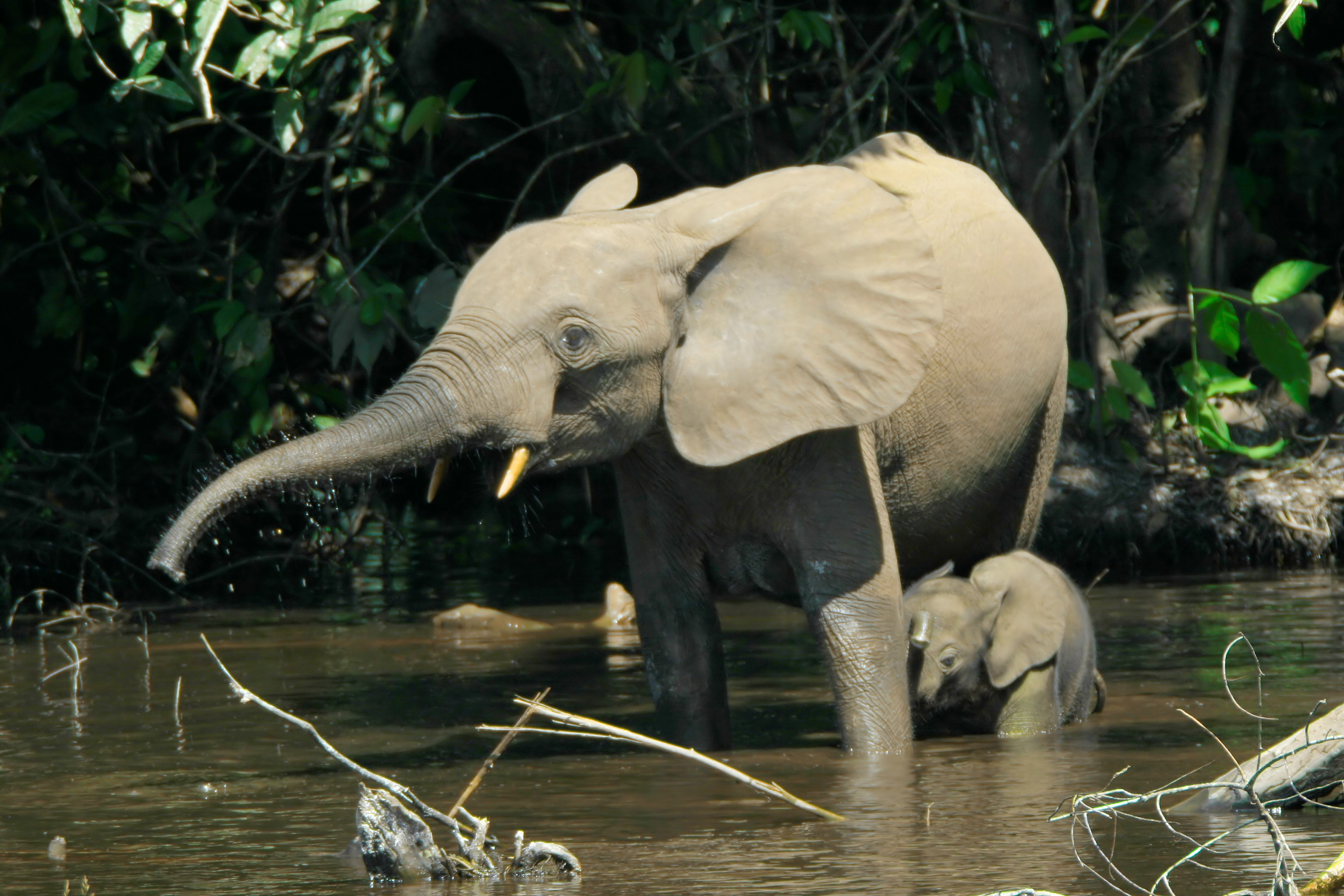
African forest elephant
The African forest elephant (Loxodonta cyclotis) is one of the two living species of African elephant. It is native to humid tropical forests in West Africa and the Congo Basin. It is the smallest of the three living elephant species, reaching a shoulder height of 2.4 m (7 ft 10 in). As with other African elephants, both sexes have straight, down-pointing tusks, which begin to grow once the animals reach 1–3 years old. The forest elephant lives in highly sociable family groups of up to 20 individuals. Since they forage primarily on leaves, seeds, fruit, and tree bark, they have often been referred to as the 'megagardener of the forest'; the species is one of many that contributes significantly to maintaining the composition, diversity and structure of the Guinean Forests of West Africa and the Congolese rainforests. Seeds of various plants will go through the elephant's digestive tract and eventually pass through in the animal's droppings (likely in a new location where they will sprout), thus helping to maintain the spread and biodiversity of the forests.
The first scientific description of the species was published in 1900. During the 20th century, overhunting caused a sharp decline in population, and by 2013 it was estimated that less than 30,000 individuals remained. It is threatened by habitat loss, fragmentation, and poaching. The conservation status of populations varies across range countries. Since 2021, the species has been listed as Critically Endangered on the IUCN Red List.[2]
Traditional hunting[edit]
African forest elephants are hunted by various hunter-gather groups in the Congo basin, including by Mbuti pygmies, among others. It is unknown how long the active hunting of elephants in the region has been practised, and it may have only begun as a response for the demand for ivory beginning in the 19th century or earlier. Elephants are traditionally hunted using spears, typically to stab at the lower abdomen (as is done among the Mbuti) or knees, both of which are effective at rendering the animal immobile. Anthropologist Mitsuo Ichikawa observed the hunting of elephants by Mbuti pygmies in fieldwork during the 1970s and 1980s, when the Mbuti used spears tipped with metal points (though earlier reports suggest that that prior to this they used purely wooden spears, which may have been less effective at breaking the elephants hide). As observed by Ichikawa, elephant hunting by the Mbuti pygmies involved both small and large groups of hunters, which was led by at least one experienced hunter called a mtuma. Before the hunt began, ritual acts of singing and dancing were performed by the community to support the success of the hunt. These hunters often went into to the forest without food, living off of wild honey and vegetables, smearing themselves in mud, elephant dung, and charcoal made from certain plants to disguise their scent from the elephants. Once the traces of an elephant are detected, it was carefully tracked, before being approached from downwind and stabbed. It typically took several hours to several days from the first stab to the death of the elephant. Many hunts failed due to elephants detecting the hunters before being stabbed and fleeing, with field research by Ichikawa finding that only 1 out of 6 Mbuti elephant hunts were successful in a 6-month period, corresponding to around 60–70 days of total hunting time, meaning that despite the large quantity of meat provided by each individual elephant, it did not provide reliable subsistence, with the Mbuti instead relying on hunting smaller animals. Following the death of the animal, the Mbuti hunters returned to their homes, with the whole community moving to dismember the elephant carcass. Meat was shared equally among the community with the exception of a few body parts which were reserved for certain community members, with the feast on the animals remains lasting for several days. Elephant hunting was a dangerous activity that was known to result in the deaths of hunters.[51]
Conservation[edit]
In 1986, the African Elephant Database was initiated with the aim to monitor the status of African elephant populations. This database includes results from aerial surveys, dung counts, interviews with local people, and data on poaching.[66]
Both African elephant species have been listed by the Convention on International Trade in Endangered Species of Wild Fauna and Flora on CITES Appendix I since 1989. This listing banned commercial international trade of wild African elephants and their parts and derivatives by countries that signed the CITES agreement. Populations of Botswana, Namibia and Zimbabwe were listed in CITES Appendix II in 1997 as was the population of South Africa in 2000.[2] Hunting elephants is banned in the Central African Republic, Democratic Republic of Congo, Gabon, Côte d'Ivoire, and Senegal.[67]
African forest elephants are estimated to constitute up to one-third of the continent's elephant population but have been poorly studied because of the difficulty in observing them through the dense vegetation that makes up their habitat.[68] Thermal imaging has facilitated observation of the species, leading to more information on their ecology, numbers, and behavior, including their interactions with elephants and other species. Scientists have learned more about how the elephants, who have poor night vision, negotiate their environment using only their hearing and olfactory senses. They also appeared to be much more active sexually during the night compared to the day, which was unexpected.[50]